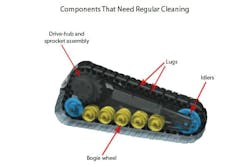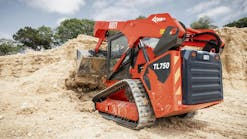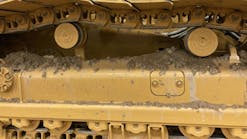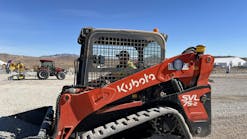Driving a steel-tracked loader over asphalt is sure to create some ground damage. Add in the high noise levels and vibrations produced by the interaction between the steel tracks and a hard surface, and it’s no surprise that many operators prefer to operate machines equipped with rubber tracks. Unlike their steel brethren, which according to Terex ASV product specialist Jodi Gulbraa are vulnerable to corrosion and stretching, rubber tracks also do not rust and weigh lighter.
“As the steel tracks travel over the terrain, they stretch and may eventually break and become abrasive to the rubber surrounding it, causing it to wear prematurely,” Gulbraa says.
But because rubber tracks have a reputation for durability and long life, several fleet owners neglect to take the proper maintenance steps. In fact, rubber tracks have their own host of maintenance issues, and inadequate cleaning and insufficient inspection will undoubtedly lead to a much shorter lifespan.
Cleaning
Perhaps the most important step to maximizing the life of rubber tracks is to wash them daily, especially after operating in harsh environments such as mud or snow, Gulbraa says. When material builds up inside the track rails, tension increases, which puts more pressure on the track itself as well as on the undercarriage components.
“Cleaning and inspecting drive rollers and bogie wheels should take place throughout the work day, not just at the end,” Gulbraa says, adding that a high-pressure water sprayer should do the job. During the winter months, “we see many operators who don’t clean the undercarriage after operation in snow. To avoid a frozen undercarriage and a headache the next morning, it is important to remove all the snow and ice from the undercarriage at the end of each work day.”
When cleaning out the undercarriage, pay special attention to the drive hubs and sprocket assembly, as those components are extremely vulnerable to wear, according to Johnny Riddle, Field Technical Support Specialist with Volvo Construction Equipment.
“The lugs on the tracks are designed to fit into the drive hubs,” Riddle says. “If the drive hubs get asphalt in them, the asphalt acts like sandpaper. Over a period of time, the track rubs across the accumulated asphalt and beats the lug completely off the track.”
If you find that a water sprayer can’t get out all the dirt lodged in the drive hubs, use a screwdriver to push out the remaining material, he says.
Operating
In addition to routinely inspecting and cleaning rubber tracks and the undercarriage to prevent wear and to optimize operation, operators should try to apply equal pressure to both tracks. For instance, locking down or counter rotating one track to make quick turns produces uneven wear.
“It’s better to make gradual turns,” Riddle says. “When you counter rotate a machine, especially when there’s a soft base like gravel, they end up kicking gravel up on the track and drive hub, which crushes the gravel. That puts premature wear on the drive hub.”
Gulbraa advises operators to make three-point turns to minimize both wear to the undercarriage as well as ground disturbance. She also says when working on inclines or slopes, operators should move the machine slowly and avoid making sudden directional changes. Working on crowns and depressions also will create uneven wear.
Inspecting
Maintenance staff should do “a visual walk-around before start up,” Riddle says. “It only takes less than five minutes to walk around, look at the track lugs, look at the track exposure to make sure you don’t see cables sticking out, and make sure you don’t see bogies worn out.”
Then every two to three months, do a more detailed inspection. Riddle advises staff to lift the machine off the ground in order to take the tension off, making it easier to determine whether the bearings in the bogie wheels have worn out or failed.
Proper alignment is also vital to ensure long track life. Volvo, for instance, requires a 10- to 12-millimeter gap in between the guide lugs and midrollers of one of its asphalt pavers to maintain optimal track alignment. Check your machine’s manual to find out how wide the lug-midroller gap should be.
Finally, tracks should be neither too tight nor too loose. Overly tight tracks can increase wear by as much as 50 percent. “A tight track magnifies the load and puts more wear on the link and sprocket-tooth contact points,” according to Alpine Rubber Co.
Small rubber-track machines usually require track sag of about 1 inch, while bigger machines need as much as 2 inches. Again, correct track tension is listed in your machine’s operator’s manual.
“If you get too much slack in that track, it will end up throwing that track off the machine,” Riddle says.
Maintaining rubber tracks is simple, Riddle says. If you clean them each day, make sure to make gradual turns and movements, and inspect them routinely, then you’re sure to reap rubber tracks’ benefits of a smoother and faster ride.





